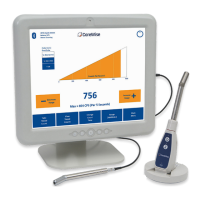6.1 Error Messages
Appendix C describes the various error messages that may
appear if the C-Trak
®
Apollo System detects any malfunction.
In the event of an error message, select YES to continue use
of the Apollo System. If the message continues to appear,
call Care Wise for guidance.
6.2 Power Supply Requirements
The power supply included with the C-Trak
®
Apollo system is
rated for 100 V-240 V AC. Do not attempt to use the Apollo
system with any voltage below 100V or above 240 V. The power
supply included with the Apollo system transforms the incoming
AC current and provides the system with 12 V DC current at a
maximum of 8.33 A.
CAUTION: Use only a power supply and power cord
provided by Care Wise specifically for the C-Trak
®
Apollo System to prevent the occurrence of
shock, fire or product damage.
6.3 Disassembly
Do not attempt to disassemble or otherwise service the
probe, analyzer unit, or power supply. There are no
user-serviceable parts.
DISASSEMBLY VOIDS THE WARRANTY AND TRANSFERS
ALL CONTINGENT LIABILITY TO THE INDIVIDUAL
AND INSTITUTION INVOLVED.
6.4 Lithium-Ion Battery Care and Maintenance
The Apollo wireless handset contains a rechargeable
Lithium-Ion battery.
Lithium-Ion rechargeable batteries require routine maintenance
and care in their use and handling. Please read and follow the
guidelines in this section to safely use the Lithium-Ion batteries
contained within the handset and hence achieve the maximum
battery lifespan.
Overview
Do not leave Apollo handsets containing batteries unused for
extended periods of time. When a handset has been unused
for 6 months, check the charge status and charge accordingly.
The charge status is indicated in the top, left-hand corner of
each main screen in the Apollo software.
The typical estimated life of a Lithium-Ion battery is about two
to three years or 300 to 500 charge cycles, whichever occurs first.
One charge cycle is a period of use from fully charged, to fully
discharged, and fully recharged again.
Rechargeable Lithium-Ion batteries have a limited life and will
gradually lose their capacity to hold a charge. This loss of capacity
(aging) is irreversible. As the battery loses capacity, the length of
time it will power the Apollo handset decreases.
Lithium-Ion batteries continue to slowly discharge (self-discharge)
when not in use or while in storage. Routinely check the battery’s
charge status via the Apollo software.
Maintenance
Routinely check the handset battery’s charge status via the Apollo
software – this will be displayed as a percentage value.
Use the supplied charging dock and wall-plug charger to charge
the handset as the primary means of charging. The USB
connection into the PC base unit should only be used to trickle-
charge the handset battery in emergency situations and not to
charge the battery fully.
Further details on low battery level indications may be found in
Appendix C (Figure 36).
Please contact Care Wise Support to arrange for the handset
battery to be replaced with a new one if you note either of the
following conditions:
1) The battery run time drops below about 80% of the original
run time (typically 4 hours’ continuous use when new).
2) The battery charge time increases significantly (typically 2-4
hours, depending on the charge conditions).
Important Note: The handset battery cannot be changed by the
user and must be performed by the manufacturer.
If a handset with battery is stored or otherwise unused for an
extended period, be sure to follow the storage instructions in this
section. If you do not follow the instructions, and the battery
has no charge remaining when you check it, consider it to be
damaged. Do not attempt to recharge it or to use it. Contact
Care Wise Support as soon as possible to replace the battery.
Charging
When the system is not in use,
the Apollo Handset can be
charged via the supplied
charging dock and wall-plug
USB power supply. The handset
may be placed into the dock
with the keypad facing the front
so that the micro-USB port on
the base of the handset engages
with the equivalent connector
on the dock.
A flashing blue LED at the base
of the handset will indicate that
the charging status; when fully
charged, the LED will illuminate
steady blue.
A flashing blue LED at the base of the handset will indicate that
the charging status; when fully charged, the LED will illuminate
steady blue.
In an emergency situation, the handset can also be charged via
a USB port on the underside of the PC base unit; however, this
method should not be used as the default method of charging
the handset.
Only the supplied charging devices should be used to charge
the battery of the Apollo Handset. THIRD PARTY-SUPPLIED
CHARGERS MUST NOT BE USED.
28
|
www.carewise.com
C-Trak Apollo
6.0 Safety Considerations

